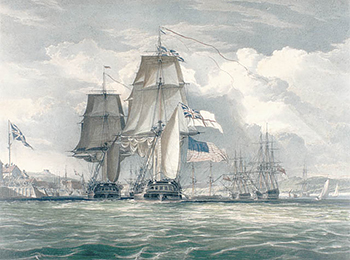Vice Admiralty Court of Halifax National Historic Event

Credit: Library and Archives Canada, Acc. No. 1970-188-1937 W.H. Coverdale Collection of Canadiana
The Vice Admiralty Court of Halifax was one of the earliest courts in Nova Scotia to adjudicate maritime civil law and administer imperial trade and revenue regulations. In times of war, the court presided over prize law, determining the legitimacy and value of captured enemy ships. The court was presided over by a judge, who alone ruled on the cases brought before the court, and the speed and efficiency of this system played an important role in fostering the seaborne commerce of the Atlantic colonies. During the War of 1812, Judge Alexander Croke ruled on over 700 American and French prizes. These captures and their valuable cargos brought unprecedented prosperity to Atlantic Canadian privateers and their merchant investors, and one of Croke’s rulings set an international precedent on the protection of cultural property during wartime.
The court administered British maritime law that had evolved since the middle ages, building on a long tradition of jurisprudence for handling disputes at sea. This system was separate from the common law and no jury was involved. The judge of the Vice Admiralty Court ruled over all cases whether they were civil, prize, or revenue related. The expediency found in this concentration of power allowed for quick decisions over time-sensitive cargos, and enabled the passing of unpopular rulings on trade avoiding juries influenced by local interests. The evolution and growth of these courts was considered critical to the economic expansion of the British Empire overseas.
In 1720, the first Vice Admiralty Court in Nova Scotia was established at Annapolis Royal, and in 1749, the court at the new settlement of Halifax presided over its first case. Soon the Vice Admiralty Court of Halifax was judging more than a case per month, on a variety of issues relating to trade regulations, prize laws, and maritime disputes from sailors’ pay to collisions at sea. The court became much more active during the wars of the late 18th century, and especially during the War of 1812 in North America.
During times of global conflict the court issued “letters of marque or reprisal” to civilian ships, known as privateers, granting permission to attack and seize enemy vessels. The value of the enemy vessel and its cargo was determined by the court, and then divided between the privateers, the Crown, and through fees, to the court itself. A particularly significant case came before the court in February 1813, when Judge Alexander Croke ruled that paintings captured by privateers which were bound for an academy in America were the cultural property of that nation, setting a long-lasting international precedent which protected art from inclusion as spoils of war.
In operation until 1891, the Vice Admiralty Court of Halifax served as a major arbiter of maritime commerce and conflict in the Atlantic region.
The National Program of Historical Commemoration relies on the participation of Canadians in the identification of places, events and persons of national historic significance. Any member of the public can nominate a topic for consideration by the Historic Sites and Monuments Board of Canada.
- Date modified :